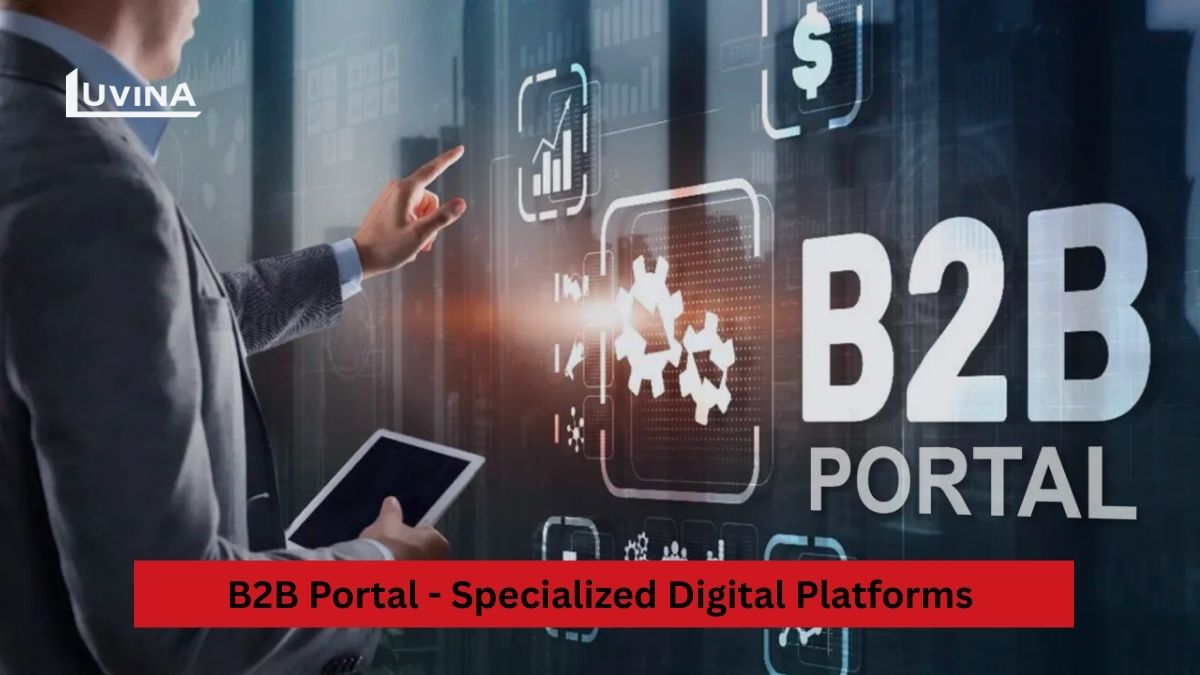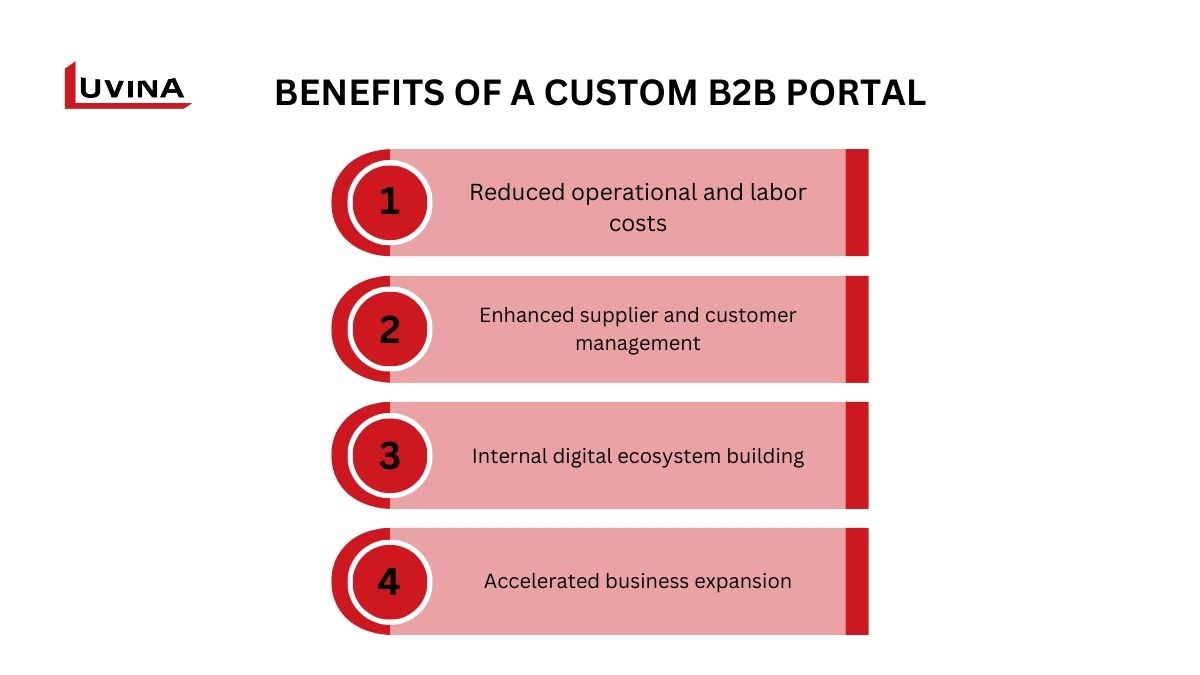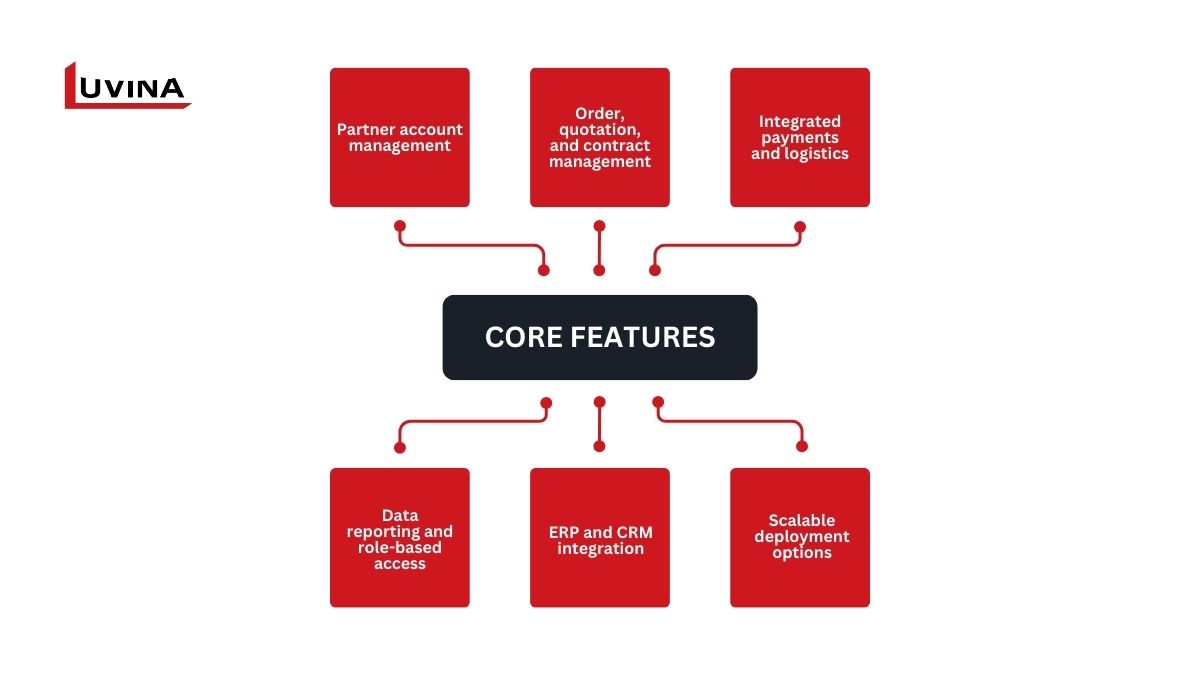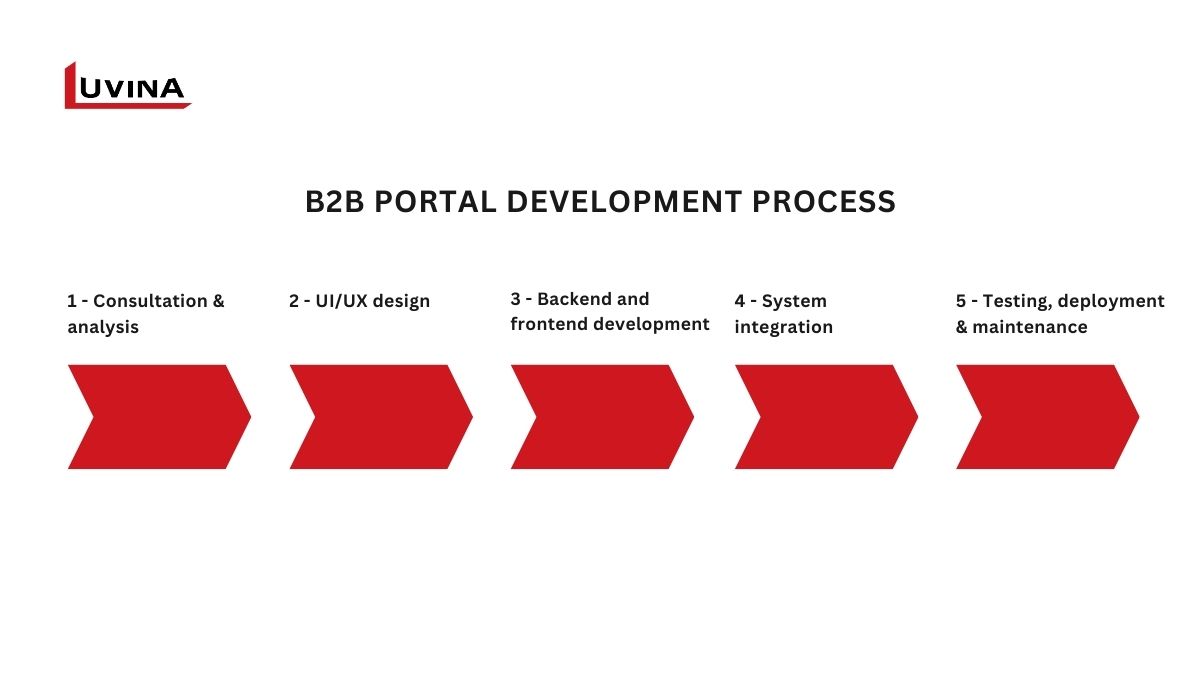With B2B portal development emerging as a critical strategy, companies are no longer just adapting to digital transformation—they are thriving because of it. The global B2B e-commerce market, already valued in the trillions, is expected to reach $18,771.4 billion by 2027. Building a B2B portal is no longer a luxury; it’s a competitive necessity.
In this article, we’ll explore the workings of B2B portals, their features and benefits, and how to build a successful platform.
What is a B2B portal? Why do businesses need it?
Specialized digital platforms called B2B portals enable transactions and cooperation among companies, including manufacturers, distributors, and wholesalers. It offers a central hub for managing consumer accounts, orders, inventory, and communication.

A B2B portal actively enables transactions, price control, custom user roles, and real-time data access; a conventional website might function as a digital brochure. For companies aiming to increase efficiency, satisfy current consumer expectations, and scale processes, this is crucial.
Real-world applications of B2B portal development span industries. For example, manufacturers use portals to track production and logistics; wholesalers rely on them to manage bulk ordering and supplier relationships; and B2B eCommerce platforms use them to handle vendor onboarding and customer self-service.
Long-term benefits of a custom B2B portal
Investing in B2B portal development goes beyond just creating a transactional solution. It’s all about setting the stage for better cooperation, smarter processes, and long-term development.
B2B web portal development offers the following long-term advantages:

- Reduced operational and labor costs: Automating repetitive activities like order tracking, invoicing, and inventory modifications helps to minimize paperwork and manual labor, therefore lowering staffing needs and increasing efficiency.
- Enhanced supplier and customer management: Real-time communication, self-service access, and improved data visibility help to simplify relationship management, performance monitoring, and quick reaction to partner or customer needs.
- Internal digital ecosystem building: A B2B portal becomes a digital backbone by connecting with key business systems (ERP, CRM, etc.), so facilitating effortless data flow and departmental coordination.
- Accelerated business expansion: B2B portals enable companies to maximize their reach to new markets, onboard partners more quickly, and meet rising demands with the least friction using scalable infrastructure, configurable features, and 24/7 access.
Core features of a B2B web portal
A successful B2B portal development project must be robust, scalable, and tailored to the real-world workflows of both buyers and suppliers. A trusted B2B portal development company will ensure that your portal includes the following core functionalities:

- Partner account management: Customizable user roles, account hierarchies, and purchasing permissions help complex organizational structures by ensuring seamless interaction with both buyers and suppliers.
- Order, quotation, and contract management: Reducing manual errors and increasing visibility, letting users place and handle orders, asking for quotes, reviewing order history, and accessing contracts.
- Integrated payments and logistics: With built-in payment methods and logistics integrations, integrated payments and logistics help to provide a smooth end-to-end experience by enabling secure transactions and automatic shipping processes.
- Data reporting and role-based access: Detailed reports on sales, use, and customer activity help to empower decision-making, while role-based access and bespoke data views help to preserve security.
- ERP and CRM integration: Integrating ERP and CRM will help you to sync client data, inventory levels, and financial records by linking with current business systems, therefore removing data silos and streamlining departmental workflow.
- Scalable deployment options: Whether you choose a SaaS cloud-based or on-premise configuration, modern B2B portals are meant to grow with your company and meet future demands.
B2B portal development process
A successful B2B portal development journey requires a strategic, phased approach. Below is a typical process followed by providers of professional B2B portal development services:

- Consultation & business analysis
This initial stage involves deep discovery sessions to understand your business model, workflows, and integration needs. It includes competitive research, stakeholder interviews, and mapping out portal requirements to define the project roadmap clearly.
- B2B-focused UI/UX design
Specialized user interface/user experience design guarantees the portal accommodates sophisticated user roles, approval flows, and data-heavy operations typical of B2B settings. To maximize usability across devices, responsive layouts, simple navigation, and role-based interfaces are given top priority.
- Backend and frontend development
This stage brings the portal to life. The B2B portal development team builds user-facing components using modern frontend frameworks while developing backend systems to handle logic, data processing, and security. This includes API development, database structuring, and system performance tuning.
- System integration (CRM, ERP, Logistics APIs, etc.)
Integrating your portal with important business systems—like CRM for customer management, ERP for resource planning, and third-party APIs for shipping, payments, or inventory—lets you create seamless data flow. These connections guarantee real-time correctness and cut down on manual work.
- Testing, deployment & long-term maintenance
The portal is extensively tested before launch. Functionality, security, and performance are all validated. Regular updates, monitoring, and improvements are essential after deployment to preserve system stability and satisfy changing business needs.
Recommended technologies for building a B2B web portal
Selecting the right tech stack is one of the most critical decisions in B2B portal development. The chosen technologies should support scalability, strong security, fast deployment, and seamless integrations with enterprise systems. Below is a breakdown of commonly used technologies.
| Technologies | Key highlights |
| Laravel | (+) Simple and clean syntax, ideal for fast development cycles. (-) Require more customization for complex B2B workflows. |
| Magento B2B | (+) Offers robust features for B2B commerce (-) Steep learning curve and can be resource-intensive to host and scale. |
| Java Spring | (+) Offers high flexibility and performance. Best for large, security-sensitive portals (-) Requires experienced developers |
| .NET Core | (+) Secure and scalable with good integration options. Suitable for enterprise-level portals (-) Higher licensing and hosting costs |
| React/Angular | React: Flexibility and is component-driven Angular: Provides a more opinionated structure, useful for complex UI with predefined standards. |
All the technologies above are open-source solutions. They offer full control, customization, and flexibility but demand in-house expertise and ongoing maintenance.
On the other hand, SaaS-based platforms (like Shopify B2B or BigCommerce B2B modules) enable quicker deployment and lower upfront costs but limit customization and may involve recurring subscription fees.
When selecting technologies for B2B portal development, it’s crucial to consider factors such as scalability, the cost of the technology stack, security, and the time required for development and deployment.
Specialized B2B portal development services with Luvina
In the creation of a successful B2B portal development solution, achieving your business requirements as well as your customers’ needs is of the utmost importance. Luvina, the top B2B portal development company, provides tailor-made solutions that cater to the unique needs of your company.

Luvina’s expert team ensures problem-free integration of your B2B portal to critical systems like ERPs and CRMs. This integrates your portal seamlessly for greater working efficiency and automated processes, so that your portal runs smoothly. The user-friendly interface does not just make customer transactions effective but also brings the entire process to a faster and better place.
With Luvina’s professional B2B portal development services, you can create a portal that attracts customers and establishes trust. Self-service features of the portal reduce the load on your employees so that they can focus more on building client relationships. This eventually results in increased customer satisfaction, improved retention, and increased revenue.
In an industry of competition where trust and better user experience matter, Luvina is the right partner to ensure the success of your B2B platform. Contact Luvina today to start your B2B portal development journey. Let us help you excel in a competitive marketplace!
>> Also read: Python development outsourcing
FAQ
How long does it take to develop a B2B portal from scratch?
The development time typically takes 3 to 6 months or longer.
Is ERP integration necessary?
While not mandatory, ERP integration can significantly enhance the functionality and efficiency of your B2B portal by streamlining data management and business processes.
Does the B2B portal support multiple languages and currencies?
Yes, a B2B portal can be designed to support multiple languages and currencies.
How much does it cost to develop a B2B portal?
The average cost of custom B2B portal development ranges from $30,000 to $60,000, depending on complexity, features, technology, and the development team’s location and expertise.









Read More From Us?
Sign up for our newsletter
Read More From Us?
Sign up for our newsletter